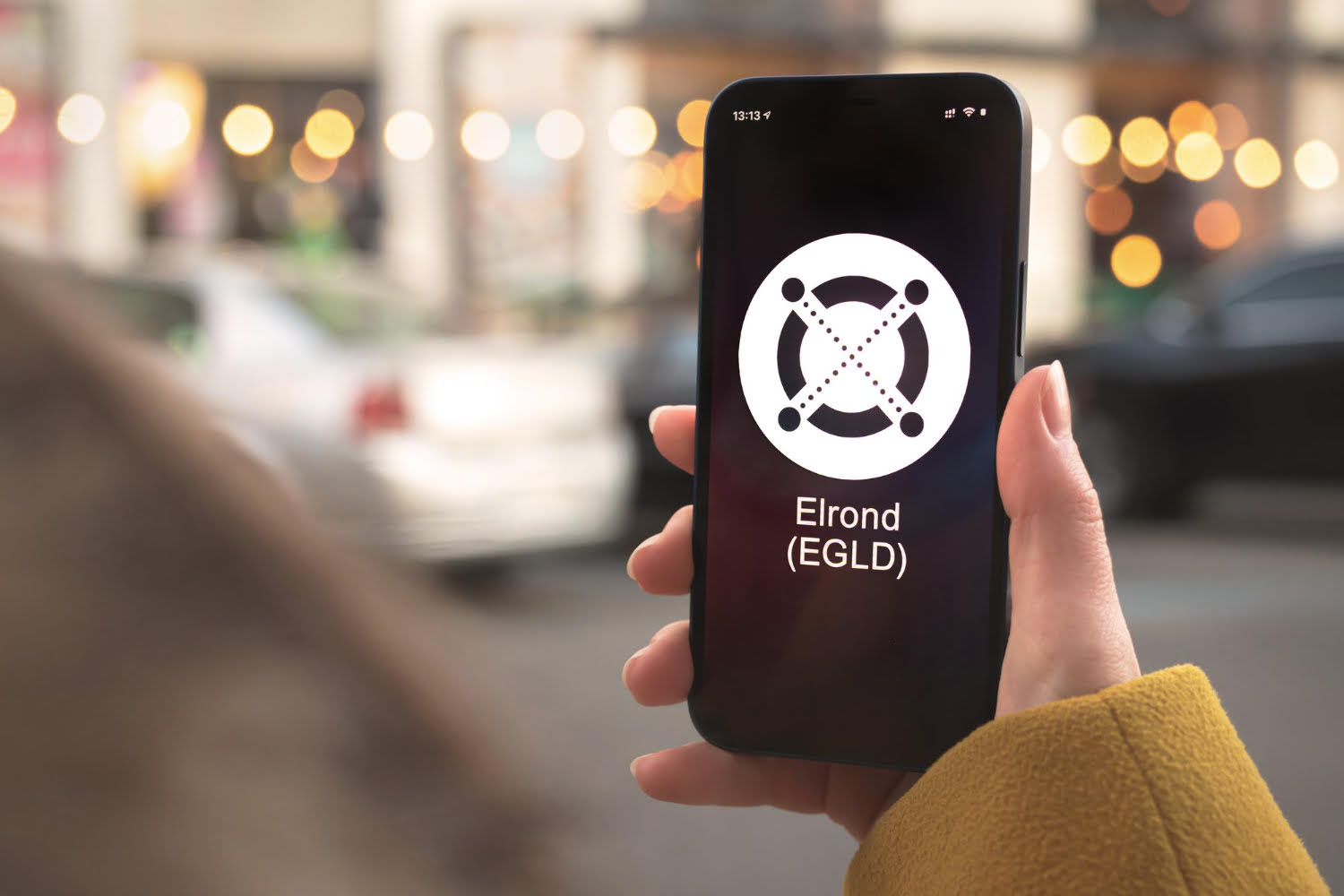

Articles
How To Store Egld
Modified: December 7, 2023
Learn how to store Egld with our comprehensive articles. Find step-by-step guides and tips to securely store your Egld and protect your investment.
(Many of the links in this article redirect to a specific reviewed product. Your purchase of these products through affiliate links helps to generate commission for Storables.com, at no extra cost. Learn more)
Introduction
Welcome to the world of Egld storage! Egld, also known as Elrond, is a highly popular and innovative cryptocurrency that has gained significant traction in recent years. As with any digital asset, the security of your Egld holdings is of utmost importance. Properly storing your Egld ensures that your funds are safe from potential threats such as hacking, fraud, and theft.
Choosing the right storage method for your Egld is essential to protect your investment. In this comprehensive guide, we will explore various wallet options available for storing Egld and provide step-by-step instructions on how to set up and use each type of wallet. Whether you prefer the security of a hardware wallet, the convenience of a software wallet, or the accessibility of an online wallet, we have got you covered.
Before we delve into the details of different wallet options, it is crucial to understand the importance of proper Egld storage. Cryptocurrencies like Egld are decentralized and rely on blockchain technology, which means that transactions are recorded in a public ledger. While this offers transparency and security, it also makes cryptocurrencies a desirable target for hackers.
By storing your Egld in a secure wallet, you maintain control over your funds and reduce the risk of unauthorized access. Additionally, utilizing a wallet provides you with the ability to easily send and receive Egld, track your transactions, and manage your holdings effectively.
Now that we have established the significance of storing Egld securely, let’s explore the different wallet options available and how you can set them up to ensure the safety of your Egld holdings.
Key Takeaways:
- Safeguarding Egld is essential to protect against hacking and loss. Choose hardware, software, or online wallets and follow best practices like strong passwords and two-factor authentication to secure your investment.
- Hardware wallets like Ledger and Trezor offer offline security, while software and online wallets provide convenience. Regularly update wallet software and stay vigilant against phishing attempts to ensure the safety of your Egld holdings.
Read more: How To Store Store-Bought Bread
Importance of Proper Storage for Egld
When it comes to storing your Egld, there is no room for compromise. Proper storage is crucial in protecting your investment from potential risks and ensuring the long-term security of your funds. Here are some key reasons why proper storage for Egld is of utmost importance:
1. Security:
The primary reason for proper storage is to safeguard your Egld from unauthorized access. Cryptocurrencies are often targeted by hackers who exploit vulnerabilities in online platforms or steal private keys. By using secure storage methods, such as hardware wallets or software wallets with robust security features, you significantly reduce the risk of losing your Egld to cybercriminals.
2. Protecting against Loss:
Proper storage also prevents accidental loss of Egld. With cryptocurrencies, there is no centralized authority to help recover lost funds. If you lose access to your Egld wallet or forget your private keys, the funds could become irretrievable. By using reliable storage methods and following best practices, you can minimize the risk of losing your Egld due to human error.
3. Avoiding Exchange Risks:
Storing your Egld in a wallet instead of leaving it on an exchange helps mitigate the risks associated with centralized platforms. Exchanges can be vulnerable to hacking or face regulatory issues, potentially compromising the safety of your assets. By keeping your Egld in a secure wallet, you maintain control over your funds and reduce the reliance on third-party platforms.
Read more: How To Store Basil From Grocery Store
4. Ease of Transaction:
A well-designed wallet makes it convenient to send and receive Egld. By securely storing your Egld in a wallet, you can easily initiate transactions with confidence, knowing that your funds are protected. This not only ensures seamless interactions within the Egld ecosystem but also enables you to take advantage of investment opportunities without delays or uncertainties.
5. Long-term Investment:
If you view Egld as a long-term investment, proper storage is crucial for its growth and preservation. By safeguarding your Egld in a secure wallet, you can withstand price fluctuations and market volatility with confidence. It allows you to maintain control over your investment strategy and ensure the longevity of your Egld holdings.
With the importance of proper storage for Egld well understood, let us now explore the different wallet options available to securely store your valuable Egld holdings.
Wallet Options for Storing Egld
When it comes to storing your Egld, there are several wallet options to choose from. Each option has its own advantages and considerations in terms of security, convenience, and accessibility. Here are the three main types of wallets for storing Egld:
1. Hardware Wallets:
Hardware wallets are physical devices that are specifically designed for securely storing cryptocurrencies. They provide an offline, cold storage solution for your Egld, keeping your private keys and funds offline and away from potential online threats. Hardware wallets offer a high level of security and are considered one of the safest ways to store Egld. Popular hardware wallet options for Egld include Ledger and Trezor. To set up a hardware wallet, you will need to connect it to your computer or mobile device, install the wallet software, and follow the on-screen instructions to create a new wallet and back it up securely.
Read more: How To Store Jordans
2. Software Wallets:
Software wallets are applications or programs that you can install on your computer, smartphone, or tablet. They offer a convenient way to store and access your Egld, with the added benefits of flexibility and mobility. Software wallets can be further categorized into desktop wallets, mobile wallets, and web wallets. Desktop wallets are installed on your computer, mobile wallets are apps that you can download onto your smartphone, and web wallets are accessed through a web browser. To use a software wallet, you will typically need to download and install the wallet software, create a new wallet, and securely back up your private keys. Popular software wallet options for Egld include Trust Wallet, Metamask, and MyEtherWallet.
3. Online Wallets:
Online wallets, also known as web wallets, are web-based wallets that allow you to store, manage, and access your Egld through an online platform. These wallets are convenient as they enable you to access your Egld from any internet-connected device. However, since online wallets store your private keys online, they may be more susceptible to hacking and other online threats. It is essential to choose a reputable and trustworthy online wallet provider with robust security measures in place. To use an online wallet, you will typically need to create an account, set up two-factor authentication for added security, and transfer your Egld to the wallet’s address. MyEtherWallet and Binance are examples of well-known online wallet options.
Now that you have a better understanding of the different wallet options available for storing Egld, the next step is to set up the most suitable wallet that aligns with your security preferences and convenience. In the following sections, we will provide step-by-step instructions on how to set up each of these wallet types to securely store your Egld.
Setting Up a Hardware Wallet for Egld Storage
If you prefer the utmost security for storing your Egld, a hardware wallet is an excellent choice. Setting up a hardware wallet requires a few simple steps. Here’s a step-by-step guide to help you get started:
Step 1: Choosing a Compatible Hardware Wallet
The first step is to choose a hardware wallet that is compatible with Egld. Popular hardware wallet options include Ledger and Trezor. Make sure to purchase your hardware wallet from an official and trusted source to avoid any potential scams or tampered devices.
Read more: How To Store Stencils
Step 2: Installing the Wallet Software
After obtaining your hardware wallet, you need to install the wallet software on your computer or mobile device. Visit the official website of the hardware wallet provider and download the appropriate software for your operating system.
Step 3: Creating a New Wallet
Once the software is installed, follow the on-screen instructions to set up a new wallet. This usually involves creating a unique wallet name, password, and a secure PIN code. Make sure to choose a strong password and always remember it, as it will be necessary to access your wallet in the future.
Step 4: Backing Up the Wallet
After creating your wallet, you will be prompted to back up the wallet. This step is crucial as it allows you to recover your funds in case your hardware wallet is lost, stolen, or damaged. Follow the instructions provided by the wallet software to securely back up your recovery phrase or seed phrase. This phrase typically consists of a series of words that you need to write down and keep in a safe place that is separate from your hardware wallet.
Step 5: Transferring Egld to the Hardware Wallet
With your hardware wallet set up and secure, you are ready to transfer your Egld to the wallet. Open the wallet software and locate your Egld address. This address is a long alphanumeric string unique to your wallet. Copy your Egld address from the wallet software and use it to initiate a transfer from another wallet or exchange. Double-check the address to ensure accuracy before confirming the transfer. Once the transfer is complete, your Egld will be securely stored in your hardware wallet.
Setting up a hardware wallet for Egld storage provides you with an added layer of security, keeping your private keys offline and away from potential threats. Now that you have successfully set up your hardware wallet, you can rest assured knowing that your Egld is in safe hands.
Read more: How To Store A Camelbak
Using Software Wallets to Store Egld
Software wallets provide a convenient and flexible way to store and access your Egld. Setting up a software wallet for Egld storage is relatively simple. Here’s a step-by-step guide to help you get started:
Step 1: Selecting a Reliable Software Wallet
The first step is to choose a reliable software wallet that supports Egld. Look for wallets that have a good reputation, strong security features, and regular updates to ensure compatibility and protection for your Egld. Trust Wallet, Metamask, and MyEtherWallet are popular choices for storing Egld.
Step 2: Downloading and Installing the Wallet
Visit the official website or app store of your chosen software wallet and download the appropriate version for your operating system or device. Once downloaded, follow the installation instructions to install the wallet software on your computer or mobile device.
Step 3: Creating a New Wallet
Launch the software wallet and look for the option to create a new wallet. This usually involves setting a unique wallet name, password, and sometimes even a PIN code. Choose a strong password and make sure to remember it, as it will be needed to access your Egld in the future. Keep in mind that software wallets generally provide a recovery phrase or seed phrase that you need to write down and keep in a safe place. This phrase is essential for recovering your wallet if needed.
Read more: How To Store Arrows
Step 4: Understanding Wallet Security Features
Take some time to familiarize yourself with the security features offered by the software wallet. This may include options like two-factor authentication (2FA) or biometric authentication. Enable these additional security measures to further protect your Egld and enhance the overall security of your wallet.
Step 5: Transferring Egld to the Software Wallet
With your software wallet set up and secured, it’s time to transfer your Egld to the wallet. Open your software wallet and locate your unique Egld address. This address is a long alphanumeric string specific to your wallet. Copy the address from your wallet and use it to initiate a transfer from another wallet or exchange. Double-check the address to ensure accuracy before confirming the transfer. Once the transfer is complete, your Egld will be stored in your software wallet.
Using a software wallet to store Egld offers convenience and accessibility while still maintaining a reasonable level of security. It allows you to manage your Egld easily and initiate transactions whenever needed. Now that you have successfully set up your software wallet, you can start securely storing your Egld and engaging in the exciting world of decentralized finance.
Online Wallets for Egld Storage
Online wallets, also known as web wallets, provide a convenient way to store and access your Egld from any internet-connected device. While online wallets offer accessibility, it is crucial to choose a reputable and trusted online wallet provider to ensure the security of your Egld. Here’s a step-by-step guide to help you store your Egld in an online wallet:
Step 1: Researching Trusted Online Wallet Providers
Begin by researching and identifying trusted online wallet providers that support Egld. Look for well-established platforms with a solid reputation for security and user experience. Research user reviews and take into consideration factors such as the wallet’s track record, security measures, and any additional features it offers.
Read more: How To Store A Telescope
Step 2: Creating an Account
Once you have chosen a trusted online wallet provider, visit their website and create a new account. Typically, this involves providing your email address, choosing a strong password, and agreeing to the terms and conditions of the wallet provider. Make sure to use a unique and secure password that you do not reuse for other accounts.
Step 3: Setting Up Two-Factor Authentication
After creating your account, it is highly recommended to set up two-factor authentication (2FA) for added security. This involves linking your online wallet to a second authentication method, such as a mobile app like Google Authenticator or receiving SMS codes. Setting up 2FA provides an extra layer of protection by requiring a unique verification code in addition to your password to access your online wallet.
Step 4: Transferring Egld to the Online Wallet
With your online wallet created and secured, you can now transfer your Egld to the wallet. Log into your online wallet account and navigate to the deposit section or look for the Egld wallet address. Copy the unique Egld wallet address provided by the platform. Use this address to initiate a transfer from your existing Egld wallet or exchange account. Ensure that you double-check the address to avoid any mistakes and confirm the transfer. After the transfer is completed, your Egld will be safely stored in your online wallet.
Remember to exercise caution using online wallets and to keep your login credentials secure. Regularly update your password and be vigilant of any suspicious activities. It is advisable to keep larger amounts of Egld stored in more secure wallet options, such as hardware or software wallets, while using online wallets for smaller and more accessible amounts.
By following these steps, you can make use of the convenience and accessibility of online wallets to securely store your Egld and manage your holdings with ease.
Best Practices for Securing Egld Stored in Wallets
Securing your Egld stored in wallets is paramount to protect your valuable assets from potential threats. Implementing these best practices will help ensure the safety and integrity of your Egld holdings:
Read more: How To Store Microgreens
1. Using Strong Passwords
Create strong and unique passwords for your wallets. A strong password should be a combination of uppercase and lowercase letters, numbers, and special characters. Avoid using easily guessable information such as personal names or dates. It is recommended to use a reputable password manager to generate and store complex passwords securely.
2. Enabling Two-Factor Authentication
Enable two-factor authentication (2FA) whenever possible. This adds an extra layer of security by requiring a verification code in addition to your password. Use authentication apps like Google Authenticator or hardware keys like YubiKey for enhanced protection. 2FA makes it significantly more difficult for unauthorized individuals to access your wallet.
3. Regularly Updating Wallet Software
Keep your wallet software up to date by installing the latest updates and security patches. Wallet developers often release updates that address vulnerabilities and improve the overall security of the wallet. Regularly updating your wallet software ensures that you are protected against known security risks.
4. Utilizing Multisig Wallets
Consider using multisignature (multisig) wallets for an added layer of security. Multisig wallets require multiple signatures from different authorized parties to approve transactions. This protects your funds from being accessed or transferred without the authorization of multiple parties, reducing the risk of unauthorized transactions or hacking attempts.
Read more: How To Store Artwork
5. Being Vigilant of Phishing Attempts
Stay aware of phishing attempts and protect yourself from falling victim to scams. Be cautious of unsolicited emails, messages, or websites that claim to be from your wallet provider but look suspicious. Always double-check the website URL before entering any sensitive information. Avoid clicking on unknown links or downloading files from untrusted sources, as they may contain malware that can compromise your wallet’s security.
By following these best practices, you can significantly enhance the security of your Egld stored in wallets. Remember that securing your assets is an ongoing process, and it’s essential to stay informed about the latest security measures and trends in the cryptocurrency space. With due diligence, you can confidently protect your Egld and enjoy the benefits of decentralized finance.
Conclusion
Properly storing your Egld is crucial to safeguarding your funds and ensuring peace of mind in the world of cryptocurrency. By choosing the right wallet option and following best practices, you can protect your valuable Egld holdings from potential threats such as hacking, fraud, and theft.
In this comprehensive guide, we discussed the importance of proper storage for Egld and explored various wallet options available. We covered hardware wallets, software wallets, and online wallets, outlining the steps to set up each type of wallet securely.
Hardware wallets, such as Ledger and Trezor, offer an offline, cold storage solution that keeps your private keys and Egld funds away from potential online threats. Software wallets, such as Trust Wallet, Metamask, and MyEtherWallet, provide a convenient way to store and access Egld with the flexibility of different platforms. Online wallets, like MyEtherWallet and Binance, offer accessibility from any internet-connected device.
It is crucial to prioritize security when storing your Egld. Best practices such as using strong passwords, enabling two-factor authentication, regularly updating wallet software, utilizing multisig wallets, and being vigilant of phishing attempts can significantly enhance the security of your Egld holdings.
Remember, the security of your Egld is an ongoing process. Stay informed about the latest security measures and always exercise caution when interacting with your wallet and handling your private keys. By taking these precautions, you can protect your Egld investments and enjoy the benefits of this innovative cryptocurrency.
Now that you have a comprehensive understanding of Egld storage and the steps to secure your Egld, you are well-equipped to make informed decisions and ensure the safety of your funds. Start implementing these practices today and embark on your journey of securely storing and managing your Egld holdings.
Frequently Asked Questions about How To Store Egld
Was this page helpful?
At Storables.com, we guarantee accurate and reliable information. Our content, validated by Expert Board Contributors, is crafted following stringent Editorial Policies. We're committed to providing you with well-researched, expert-backed insights for all your informational needs.








0 thoughts on “How To Store Egld”